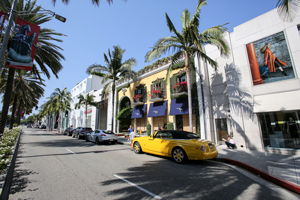
The House of Bijan’s home might soon come tumbling down.
The ritzy clothier’s Rodeo Drive site sold in July for $122 million, and sources familiar with the Beverly Hills retail market predict that the new owner, the parent of luxury lifestyle brand Louis Vuitton, will eventually replace the famous yellow storefront with a bigger building.
Maximizing the square footage at the site, between South Santa Monica Boulevard and Brighton Way, would make sense for a deal that set a California retail record of $19,405 a square foot. And it would allow LVMH Moet Hennessy Louis Vuitton Inc. to customize a snazzy storefront for one of its many luxury brands, which include Fendi, Givenchy, and Marc Jacobs.
“They don’t want someone else’s cute little building, they want their own look,” said Stephen Algermissen, executive director for capital markets at Cushman & Wakefield. “It’s all a part of marketing and branding. … That’s why it’s so incredibly valuable.”
What the acquisition means for the 40-year-old House of Bijan is uncertain.
The company had the property under contract for $108 million when owner Barton C. Brooks Trust, represented by Holliday Fenoglio Fowler’s Bryan Ley, Marc Schillinger, and Bill Fishel, decided to sell, according to two sources familiar with the deal. But rather than seeking to close the transaction it went to the market and flipped its contract to LVMH.
Ley, reached at the time of the sale in July, declined to discuss details of the transaction.
Nicolas Bijan, the retailer’s principal and son of founder Bijan Pakzad, who died in 2011, said he could not discuss the transaction or the status of its lease under a confidentiality agreement. However, he said that the brand, known for dressing President Barack Obama, basketball star Michael Jordan, and Russian President Vladimir Putin, values its spot on the world stage of luxury shopping.
“This year we are celebrating our 40th anniversary on Rodeo Drive, and we will continue to maintain a major presence on Rodeo Drive for the indefinite future,” he said via email. “There is no better location in the world than Rodeo Drive.”
Just what kind of presence remains to be seen. There are only two vacancies at present on Rodeo, according to Houman Mahboubi, senior vice president for retail at Jones Lang LaSalle. (He is the nephew of Dar Mahboubi, Bijan’s chairman and president, though was not involved in the sale.)
The appointment-only store could also seek a second-level space on Rodeo, substantially cheaper than a ground-floor presence.
A representative for LVMH, which has a flagship Louis Vuitton store on Rodeo as a tenant, declined to comment.
Record-setter
The all-cash sale for Bijan’s two-story, 6,287-square-foot site eclipsed the Rodeo record, set in December, when Chanel Inc. purchased its store for $152 million, or $13,217 a square foot. Chanel had purchased the neighboring store in 2013, then occupied by Lladro USA Inc., for $120 million, or $7,440 a square foot.
Bijan occupies a 7,629-square-foot lot, less than one-fifth of an acre. If the site is indeed a teardown, the purchase price would equate to land value of nearly $698 million an acre. The new owner can replace the existing structure with a three-story, 15,258-square-foot building, the maximum allowed under city density regulations.
Should LVMH choose to pursue a ground-up project on the Bijan site it would join other chic Rodeo retailers that have built flagships from scratch to showcase bold architecture and fancy amenities. Saint Laurent opened a four-story shop lined with white marble and outfitted with a private dressing room on the third floor in 2014. Burberry the same year constructed a three-story building with a penthouse fitting room, kitchen, and garden terrace.
Chanel is next up for a major facelift. The fashion house is proceeding with plans to build from scratch on its Rodeo sites, which together form a 15,250-square-foot parcel. A 2014 Beverly Hills Planning Commission report said Chanel intended to build a three-story shop with a rooftop deck. A city spokeswoman said company representatives have been meeting with city planners, but have not yet submitted updated designs. An attorney for Chanel declined to comment.
LVMH and Chanel are among a growing number of high-end retailers choosing to become their own landlords. Instead of paying skyrocketing rents, the companies can instead funnel money into a solid, albeit costly, real estate investment.
“If Chanel were to lose the corner of Brighton and Rodeo at the end of their lease, Chanel would be out of the market for the next five to 10 years,” said Robert Cohen, vice chairman at brokerage RKF. “They’re protecting their position.”
It’s a purchase that makes much more sense for retailers than investors, said Jay Luchs, executive vice president at Newmark Grubb Knight Frank.
“An investor that wants to put brands there and lease it is not going to get a high enough rent to pay the mortgage,” he said.
Opportunities to buy along the two-and-a-half block stretch are rare, especially with many landowners holding on to property bought in the 1970s and ’80s, according to Mark Tronstein, president of the Rodeo Drive Committee, a nonprofit that promotes the street as a shopping destination.
“People believe in in the longevity of the street,” he said.
